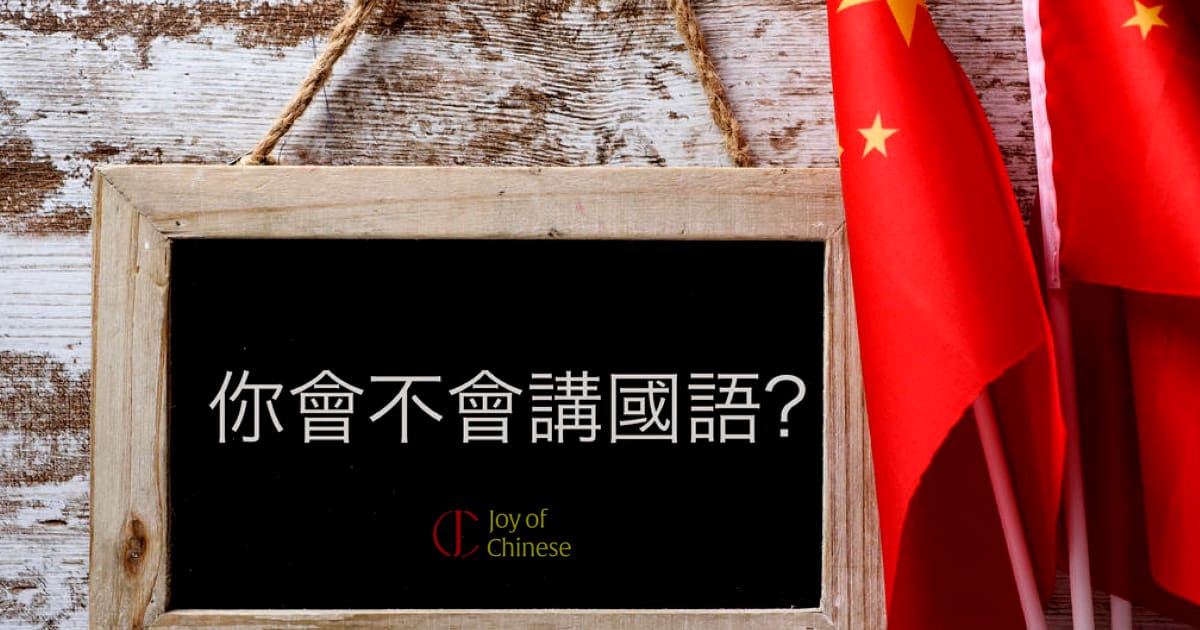Do you have good reasons to study Chinese? But which one? Do you know the Chinese language comes in hundreds of forms and varieties?
Yes, that is right!
Similar to the Indian language, Chinese itself is not a single language. Instead, it is a broad term for over 300 languages and dialects spoken in mainland China and other parts of the world.
This extensive guide will help you discover the different types of Chinese languages.
So, with no further ado, let’s begin!
Table of Contents
- Overview of the Chinese Language
- Most popular languages and dialects of China
- Written forms of Chinese
- Final words on types of Chinese language
Overview of the Chinese Language

China is a big country with over 1.4 billion inhabitants. Its population is more than Europe or combined North and South America.
The Chinese language is also called Sinitic (汉语 / 漢語 / Hànyǔ / 中文 / Zhōngwén). It is a sub-branch of a larger Sino-Tibetan. We also often name Standard Chinese, Mandarin, or Putonghua (Spoken).
Chinese is the first language of 1.3 billion people worldwide (or about 16 percent of the global population).
It is a commonly heard statement that ‘Chinese’ is the language of China. But this is a myth because ‘Chinese’ is an all-around word for hundreds of languages and dialects spoken in China.
The People’s Republic of China is the place for many language families subdivided into various categories of languages. It also varies as per region.
For example, Sino-Tibetan covers a vast area of China with over 1.1 billion speakers.
This family has many broad language categories, like Mandarin, Yue, Wu, Jin, Min, Hakka, Huizhou, Ping, Gan, and Xiang. It is further subdivided into diverse languages and dialects.
Due to sheer size in terms of area and population, there are enormous variations among them.
As a result, they are pronounced regional variations in sound, vocabulary, and grammar. Most varieties are not mutually intelligible either.
The official status of the Chinese language
With over 1.3 billion speakers, the Chinese language is the most spoken native language globally. Almost one in six people globally speak Chinese!
China isn’t the only country that speaks the Chinese language.
It is valuable in many nations and places, primarily Asian and south-east regions. For instance, Macau, Taiwan, Hong Kong, Indonesia, Mongolia, Malaysia, Philippines, Brunei, Singapore, etc.

Standard Chinese, based on the Beijing dialect of Mandarin, is the official language of both China and Taiwan. Besides, it is one of the four official languages of Singapore and one of the six official languages of the UN.
Mandarin is the most suitable if you wish to make a career involving Chinese.
But most people in Macau, Hong Kong, overseas Chinese communities, and southeastern China speak Cantonese.
In the written form, there are two types – simplified and traditional.
China, Singapore, and Malaysia use the simplified form. In contrast, the Republic of China (Taiwan), Macau, Hong Kong, and overseas Chinese diasporas employ traditional characters.
Why does China have so many languages?
This is like asking, “Why does Europe or India have so many languages?”
Because of China’s vast area, population, old surviving civilization, several ethnic groups, and highest number of neighbors, it is natural to have many languages.
The country’s demographics comprise 56 officially acknowledged ethnic groups. There are also dozens of unrecognized minority racial groups. All have played a vital role in developing various languages spoken in China.
Han’s ethnicity makes up roughly 92% of the population but has many subgroups. Also, they speak distinct Chinese language varieties as per the location, history, and native place.
All ethnic groups are distinct from one another, even in a minor sense, compared to the world outside.
China shares borders with 14 nations, 2 autonomous regions — Macau and Hong Kong, and maritime with a few more countries like Japan and South Korea.
But in the past, with no border like today, it was a confluence point for many great cultures, which led to interactions and migrations.
As a result, many languages from other families are present in today’s China. E.g., Kra–Dai, Turkic, Mongolic, Tungusic, Austroasiatic, etc. This influenced many language groups and races to grow, particularly near current border regions.
While most people believe China is a homogenous country in terms of its language. That is not the case, as seen above from its vast ethnic diversity.
With these immense varieties, there are bound to contrast! The variations between languages, accents, and dialects are a controversial topic yet too tempting to be skipped.
Chinese languages Or Dialects?
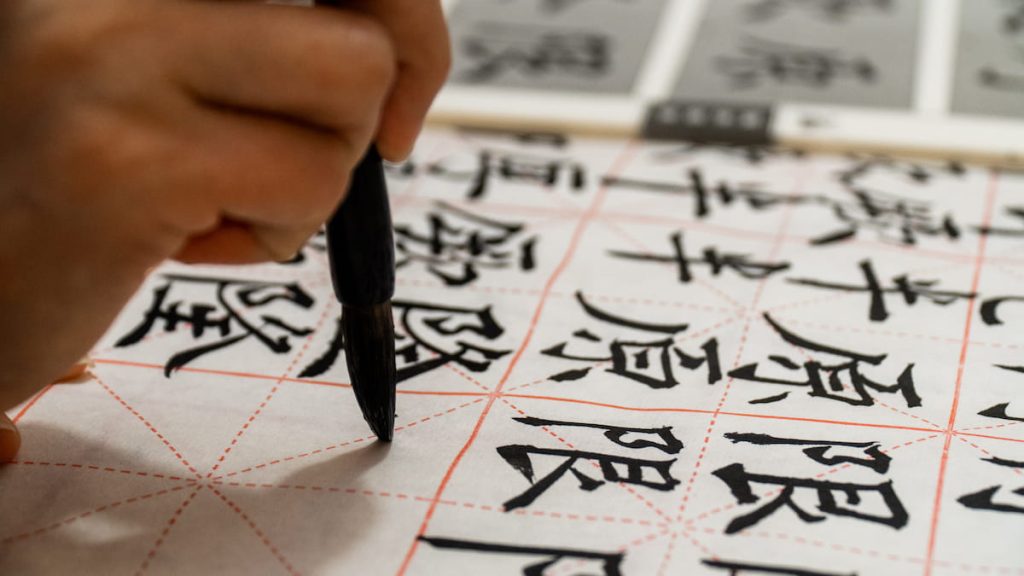
According to linguists, the land of China is home to about 300 languages and dialects that people still communicate, even in small numbers.
Ethnologue research provides precise 306 languages listed for China. Of all these living languages, 279 are indigenous, and 26 are non-indigenous.
While they fall under the blanket of what people call ‘Chinese,’ they are all named in different dialects.
Many so-called “dialects” can even pass off as an absolutely distinct language and are not mutually intelligible. But, again, this is because of the variety of China’s geographical and territorial differences.
Like other languages, these local tongues are natural languages derived from different language families and regions. So, naming them “dialects” would be misleading and unfair.
There are reasons such dialects are believed to be distinctive languages by philologists. And you should note that it is not just an articulation that distinguishes them.
They sometimes have a completely different vocabulary, grammar rules, honorifics, and sounds. It could be mutually unintelligible in some aspects but deviate in many parts.
To explain, consider the example of the American, Australian, and British accents of English. Three speakers, each with an unfamiliar accent, can still understand each other in a normal conversation.
But, this might not be the case for two dialects of Chinese, such as Mandarin and Cantonese. That is because these two are not mutually intelligible. In short, both are two separate languages.
Many Chinese dialects are at least as diverse as Romance languages like French, Spanish, Italian, or Portuguese. So, we should classify these shows that they as distinct. Yet, many are usually described as dialects for various reasons.
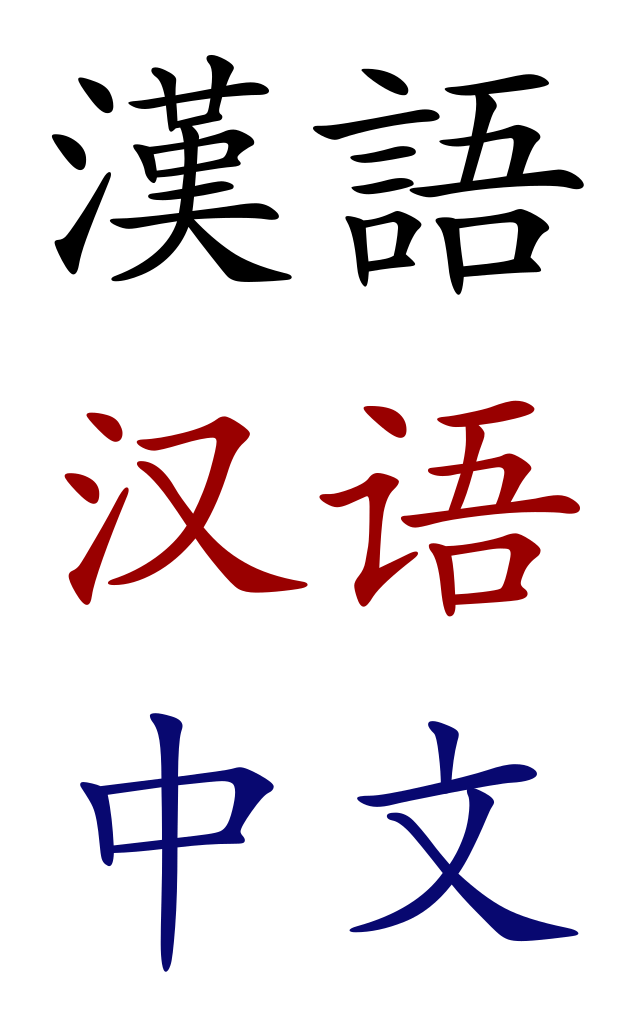
Also, because most of them are spoken locally and not taught. There are no meaningful means to teach them other than hearing or immersion.
It’s also worth mentioning that accents can occur within dialects because of regional variances in their use. This could lead to the formation of sub-dialects as well.
Varieties of Chinese language
Linguists have made seven to ten classifications of the primary language groups. This list includes, but is not limited to.
- Mandarin (often known as Northern Chinese, which is the most widely spoken),
- Wu (which is spoken around Shanghai’s shoreline),
- Jin (63 million speakers in northern China),
- Yue (also includes Cantonese and Taishanese),
- Huizhou (Mostly used in and around Huizhou),
- Xiang (a dialect of Southern China’s Huan province),
- Pinghua (Mainly in Guangxi Zhuang Autonomous Region),
- Min (a Fujian dialect that is also spoken in Taiwan),
- Gan (also known as Kan, a Chinese language in many regions, including Jiangxi and Fujian),
- Hakka (made up of 13 dialects and is expressed primarily in remote areas).
The largest of this classification is Mandarin (also known as Northern). It is subdivided into many sub-categories. Since this is more widespread than others, Mandarin is beneficial.
Wu, Min, and Yue have their own set of sub-dialects. Wu, for example, comprises multiple sub-dialects. These include Shanghai, Suzhou, and Hangzhou.
These are mutually intelligible to some extent. Still, many other sub-dialects are not understandable with these three.
Most popular languages and dialects of China
With so many language groups, it would be difficult to cover even half of them. That would be an almost impossible thing to write.
But I can cover important ones that cover over 95% of the population. So, let’s explore ten of these main linguistic language groups.
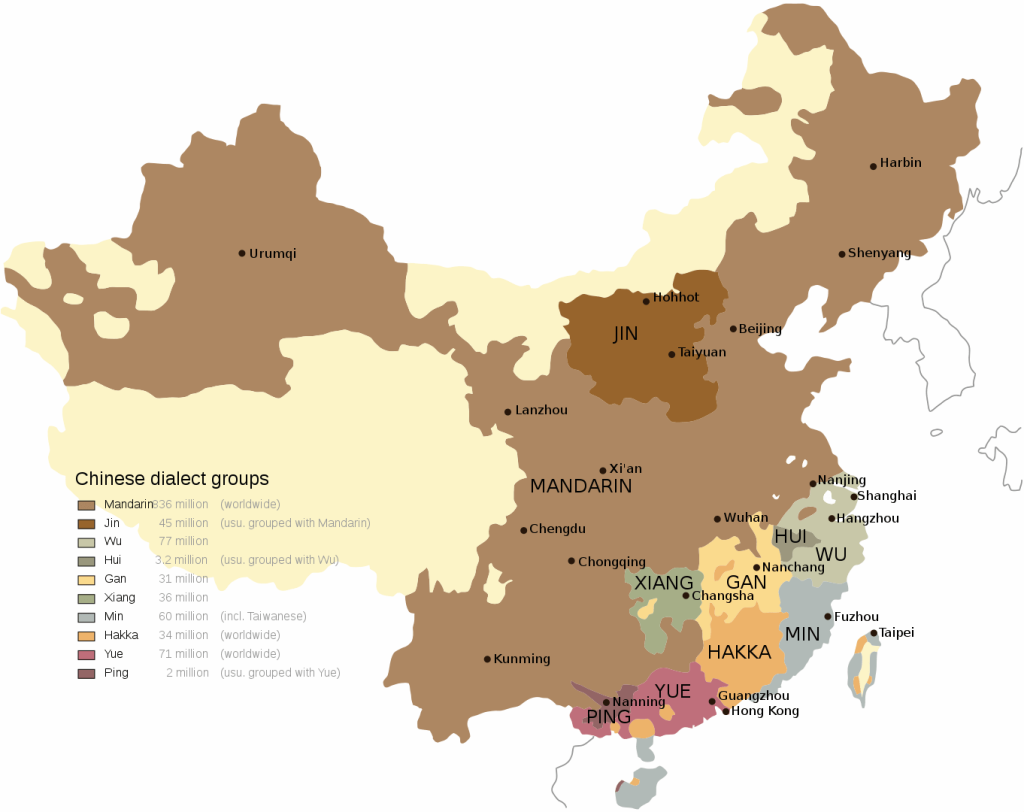
1. Mandarin (官话 / 官話)
Standard Chinese language, or Putonghua, is mainland China’s official national language. It acts as a lingua franca among the Mandarin-speaking areas. Around 70% of the people in China use it.
Mandarin has many versions. For example, Beijing, Southwestern, Standard, Jilu, Malaysian, Taiwanese, Singaporean, Zhongyuan, Northeastern, Lan-yin, etc.
The standard version is based on the Beijing Mandarin dialect and, to a lesser extent, across the other regions of mainland China. It is considered the second most spoken language in the world.
Many also speak the official languages in many other autonomous areas. Tibetans, for example, have official status in Tibet’s Autonomous Region, whereas Mongolians have official status in Inner Mongolia.
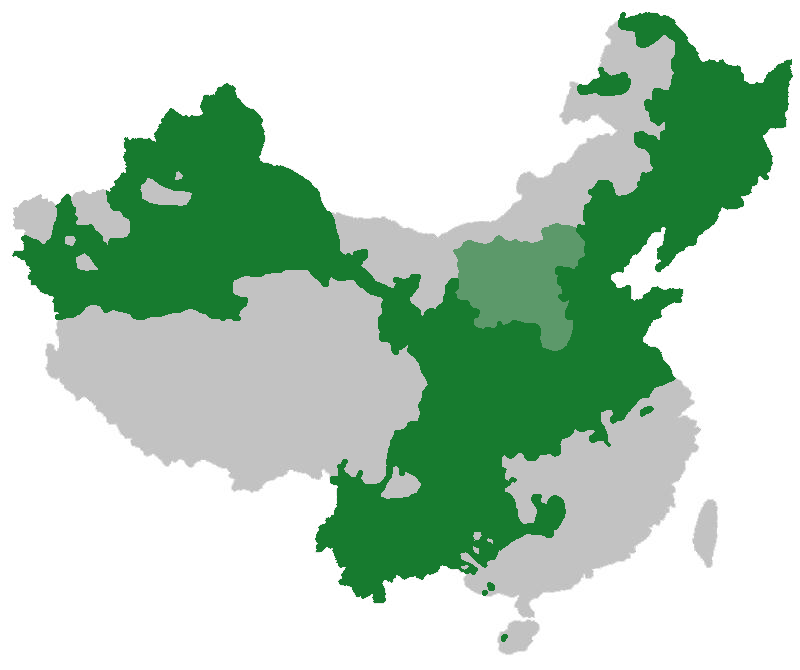
Hong Kong and Macau have different official languages (Cantonese, English, and Portuguese) than the mainland. Thus, they are exempt from Mandarin Chinese language restrictions.
Do you wish to take one of the Mandarin language exams? The good news is you have two options — HSK from China and Taiwan’s TOCFL.
2. Wu (吳語 / 吴语)
The Wu or Shanghainese is a significant group of Sinitic languages. These dialects are spoken mainly in China’s eastern area, particularly in Shanghai and the southeastern provinces of Jiangsu and Zhejiang.
We have colloquially known the language of Wu Chinese as Wyuèy, Goetian, or Changzhou.
They estimate Wu speakers in China to be over 85 million. Initially, the Wu language spread from Suzhou, China’s cultural capital.
Yet, it gained prominence during the Ming era when Shanghai established itself as a major metropolis.
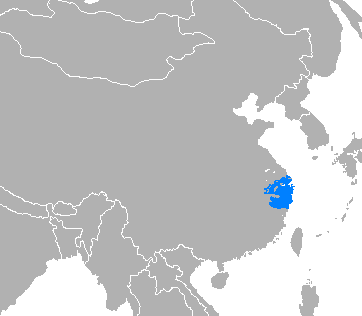
It is spoken in parts of many provinces, including Zhejiang, Jiangxi, Jiangsu, Fujian, Anhui, and the Shanghai municipality. Wu is the Chinese language’s second most widespread dialect.
3. Yue (粤语 / 粤語)
Yue is another language in China that is distinct and not mutually intelligible from the other Chinese dialects.
We popularly know it as Cantonese but also go by the names of Yueyu, Yuet Yue, and Yueh in regional terms. In terms of use, it is second only to Mandarin.
Around 62 million people in China communicate in Yue. But 73.5 million Chinese people worldwide also speak it.
Although it is only spoken by 5.6 percent of the population, it is linked with Hong Kong martial arts films.
You can find many top-rated Cantonese movies to learn Chinese. The diaspora from China has also given it greater international recognition than many other Chinese dialects.
They primarily speak Cantonese in Guangdong, Hunan, and Hainan provinces and the Guangxi Zhuang Autonomous Region. There are ten sub-dialects of Cantonese, with the Guangzhou variant being the most common.
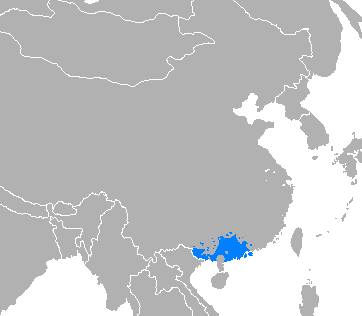
Outside mainland China, many speak Cantonese in Australia, Brunei, Canada, Hong Kong, Macao, Indonesia, Malaysia, the Philippines, Singapore, Suriname, Thailand, and Vietnam.
Its origins may be traced back to Guangzhou, also known as Canton, thus gaining Cantonese. Many aspects of Ancient Chinese are still present in Cantonese, such as the usage of final consonants.
It contains six tones, and despite having fewer starting consonants, it has multiple unique syllables.
Before the mid-twentieth century, most Chinese immigrants spoke Cantonese or Yue. But, because of language standardization by the Government of China, it is being overtaken by standard Mandarin Chinese.
Today, Cantonese is the second most popular Chinese language after Mandarin globally.
4. Xiang (湘语 / 湘語)
They root the Xiang or Hunanese dialect of the Chinese language in Hunan province in Southern China. Here, this is the most commonly spoken dialect.
The topography of the southern province is such that Mandarin-speaking states surround it. Thus, the Xiang dialect is heavily influenced by the standard Mandarin Chinese.
That’s why the Xiang dialect is the closest to Mandarin among the primary groupings of the idioms of Chinese. There are two sub-dialects of the language, which are named New Xiang and Old Xiang.
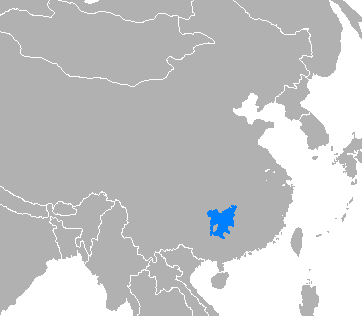
While Changsha, Hunan’s capital, speaks the new variation of Xiang, Shuangfeng and several other locations in Hunan are dominated by the older variety.
Besides being like Mandarin, Old Xiang is akin to the Wu dialect of Chinese.
There are around 36 million Xiang speakers in China, as per estimates. Like other Chinese languages, Xiang is tonal, with five distinct tones denoting different meanings.
5. Min (闽语 / 閩語)
Min Chinese is a set of languages or dialects spoken predominantly in Fujian’s coastal region. Native Min speakers make up about 10.3 million of China’s population.
There are many diverse kinds of Min and comprise the most variants. It is possibly because of the physical isolation caused by Fujian’s rugged topography.
The Fujian province, as well as areas of Guangdong, Zhejiang, Hainan, and Taiwan, speak Min languages.
We separate them into many groups, ranging from seven to 10. Inland (Northern and Central) and Coastal (Eastern, Pu-Xian, and Southern) are two broad groupings.
Northern Min, which is focused around Fuzhou, and Southern Min, which is centered on Amoy. Roughly 48 million people in China and Taiwan spoke of southern Min.
It is not mutually intelligible with other Min dialects or Standard Chinese.
Hokkien is a well-known Min variation. This is a Southern Min dialect from Fujian’s southeastern region and is also spoken in the Republic of China (ROC), i.e., Taiwan.
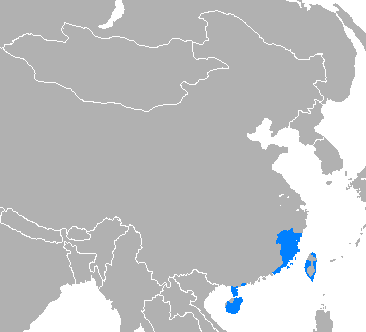
In addition, members of overseas Chinese communities in South East Asia and China towns in many nations, including the United States, speak Hokkien.
The Min dialect also has other common sub-dialects. For example, min Nan is a language spoken by around 50.5 million people in Taiwan and Southeastern China.
It also has many idioms, such as Amoy and Xiamen. Plus, the sub-dialects Min Dong, Min Bei, and Pu-Xian are also commonly spoken, with some overseas speakers from Singapore and Malaysia.
The Min Zhong sub-dialect is sometimes known as Southern Min or Central Min. It is spoken in the Fujian province’s Yong’an and Sanming municipalities and the county of Sha.
Min people also employ a dialect known as Tang Min, which maintains the final consonants used in Ancient Chinese for literary reasons.
Min is a hybrid of grammar and vocabulary from many times in the history of the Chinese language.
While there are many Min speakers, the evolution of the dialect has made it challenging to get the appropriate Chinese characters. This is because most of them were designed for the Mandarin language.
As a result, written Min substitutes Roman characters for Mandarin characters that aren’t available.
6. Gan (赣语 / 贛語)
We also know the Gan dialect of Chinese as Xi, Kan, or Jiangxinese. They speak this dialect majorly in parts of Western China.
Over 41 million people speak one or the other variant of Gan, which as a dialect is unique from Mandarin and different Chinese dialects.
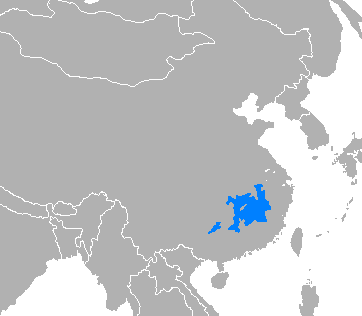
The primary centre is Jiangxi province. Anhui, Fujian, Hubei, and Hunan provinces surrounded it.
Scholars have identified five basic dialects: Changjing, Yiping, Jiliang, Fuguang, and Yingyi.
All of which are partly identical and understandable to the standard Mandarin and the Wu group. Yet, it shares most of its similarities with Hakka.
Many ancient phrases no longer used in Mandarin are still intact and survived by the Gan dialect.
7. Hakka (客家话 / 客家話)
Hakka noodles sound pretty familiar now, don’t they?
After Mandarin and Cantonese, Hakka Chinese or Kejia (Kèjihuà) is arguably the most well-known Chinese language outside of China. Many widely use it in many overseas Chinese communities.
Guangdong, Fujian, Guangxi, Hainan, Sichuan, Jiangxi, Guizhou, Hong Kong, and Taiwan have over 48 million Hakka-speaking populations.
We may also find speakers in China towns all over the world, including Singapore, Indonesia, and Malaysia.
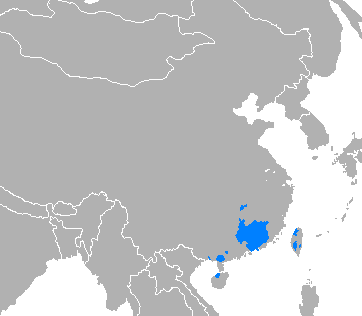
The Hakka of Mei County in Guangdong is the most well-known dialect, with structural resemblances to Cantonese and the Standard Chinese language.
Hakka is also the most closely related language to Gan, which we often refer to as a dialect of the other. Still, Cantonese was probably the source of most of the vocabulary in both tongues.
The intriguing history of the Chinese Hakka variations and the Hakka (Kejia) people shows how conflict and migration have shaped China’s linguistic environment.
8. Jin (晋语 / 晉語)
A proposed group of varieties of the Chinese language is the Jin variant.
There is disagreement among language experts regarding Jin’s status. Some connect it to Mandarin. While others distinguish it as a closely related but separate language like Min and Yue.
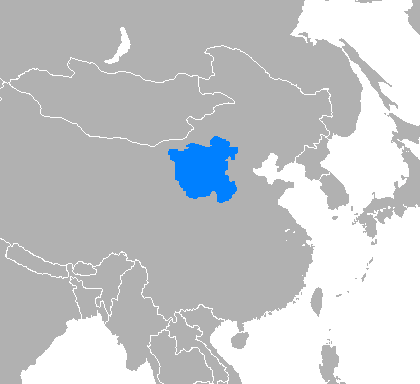
About 63 million people speak Jin Chinese in northern China. This includes most parts of Shanxi province, central Inner Mongolia, and adjacent parts of Hebei, Henan, and Shaanxi.
According to the Language Atlas of China, there are 8 subgroups of Jin. For example, Bingzhou, Bingzhou, Da-Bao, Wutai, Shangdang, Lüliang, Zhi-Yan, and Han-Yan.
9. Huizhou (徽语 / 徽語)
An area around Huizhou in and around the historical region of Huizhou speaks Huizhou Chinese.
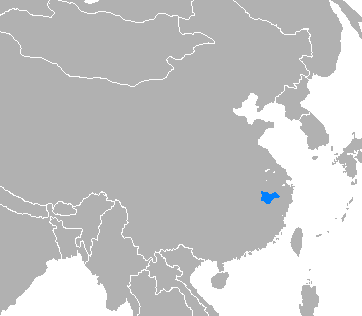
It is a group closely related to Sinitic languages. Also, a few more counties in Zhejiang and Jiangxi and many mountainous areas in southern Anhui speak Huizhou.
Hui dialects display high internal variation, even though their area is small compared with other Chinese dialects. Someone living in another county can not understand since almost every county has a distinct dialect.
That is why most Hui speakers know 2 or 3 varieties of this language. Around 4.6 million speakers of Huizhou idioms.
10. Pinghua (平话 / 平話)
They primarily interact in Sinitic languages Pinghua in Guangxi Zhuang Autonomous Region and Hunan province. Plus, there are some speakers in other areas.
Most Pinghua speakers are genetically different from most Han Chinese, and some are officially classified as Zhuang.
In the northern subgroup, they center Pinghua on Guilin. In the southern subset, it is Nanning. They are further subdivided into 3 subgroups: Yongjiang, Rongjiang, and Guandao.
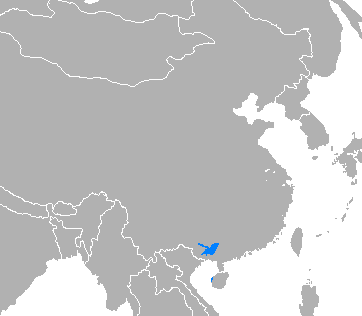
Southern Pinghua has many unique features. For example, four distinct checked tones. It also uses different loanwords from the Zhuang languages, such as the final particle Wei for imperative sentences.
11. Other languages
China is home to so many dialects of Chinese and languages that even a book series cannot cover every aspect.
Other significant languages include Bai Chinese, dozens of varieties of Tibeto-Burman, and the Danzhou dialect. And the list is never-ending.
Many language families are also prominent in China. For example, Kra-Dai, Hmong-Mien, Turkic, Mongolic, Austroasiatic, Austronesian, Yeniseian, Tungusic, and some unclassified and mixed ones.
Foreign languages in China include English. It is an official language in Hongkong, and Portuguese, an official language in Macau. Therefore, if you intend to work as an English teacher in China, it can benefit you.
Millions of people in China also know and speak Korean, Russian, Tajik, Japanese, Kyrgyz, Kazakh, Vietnamese, Mongolian, and other languages of bordering countries.
Written forms of Chinese
Even though there are several Chinese dialects and languages in China, written Chinese is the most widely used mode of communication.
Individuals in separate provinces cannot converse orally; they may comprehend each other in writing.
Broadly speaking, here are three written forms in China.
They use traditional Chinese in Taiwan, Macau, Hong Kong, and Chinese diasporas. Simplified for mainland China, Malaysia, and Singapore.
They have streamlined the traditional Chinese alphabet into a simplified one. We accomplish this by combining character with stroke reduction.
We still employ traditional Chinese in official situations and highlight particular words and phrases in mainland China. But despite all, it has declined in everyday use.
There is plenty of use of traditional Chinese in many global media, including subtitled video footage from Hong Kong and Taiwan.
Final words on types of Chinese language

So here is it. So next time someone says, Chinese language, you know it is for 300 varieties.
With so many variations that could be viewed as separate languages, ‘Chinese’ is a vast family of languages. Each has its own legacy and story to tell, which are worth exploring.
It is a paradise of linguistic mosaic for anyone passionate about language. Studying Chinese opens an exciting window into the country’s rich history, vast geography, stunning customs, and ethnic variety.
Although Chinese comes in many flavors, Standard Mandarin is China’s most spoken and official language.
Nearly two-thirds of the population of China speaks this language. Thus, the advantages of learning Mandarin are immense.
When most learners say, “I am studying the Chinese language,” they refer to Mandarin. This is because most educational institutions also teach this language only.
Do you plan to learn one form of Chinese, or perhaps you already speak Mandarin? Then, you can share your views in the comment below.
